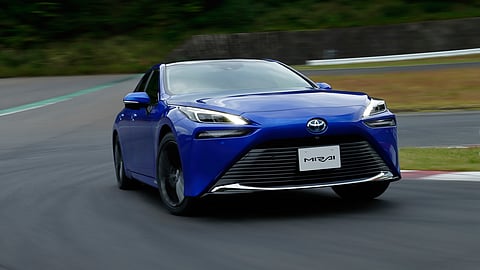Knocksense EV Series| Hydrogen or Electric Vehicles? What's in store for us?
With global advancements towards reducing carbon emissions in transportation and mobility, it is high time that we look for sustainable alternatives. Two technologies have emerged as viable solutions in terms of mobility and conserving fossil fuels- battery EVs and hydrogen fuel cell vehicles (HFCV).
Though HFC vehicles are not available for public use in the Indian market, it's comparison to EVs is crucial. The question that lingers around both these options is, which of the two is most suitable for a country like India? Well, here we will discuss key factors like range, charging times, cost, safety, infrastructure and emissions and find out what's best for us.
How do Hydrogen and EVs work?
As the name suggests, EVs work on sourcing their main power from an electric grid. Whereas, a hydrogen-powered vehicle runs on pressurised hydrogen gas sourced from a hydrogen station that uses electricity as a secondary source.
This means the production of hydrogen will require separate infrastructure, raising the overall cost of vehicles. However, both technologies run on a motor powered by electricity.
While, both the sources will advocate the zero-emission target, its reliability is of grave concern. To achieve Net Zero carbon emission by 2070, the nation will have to shift over 50% of vehicles on road to EVs or Hydrogen-powered by 2030.
Comparing crucial factors
Range:
While talking about the range of EV or Hydrogen-powered vehicles, the latter takes the centre stage here. With electric cars, the range is highly dependent on which vehicle you buy.
The more expensive vehicles, like the MG ZS EV, have a range of 461km compared to a real-world range of 300km for a less expensive TATA Nexon EV. Hydrogen fuel cell vehicles on the other hand offer greater ranges. The Toyota Mirai, for example, can manage 650km.
Charging/Refueling Station Availability:
Since both technologies are nascent, the infrastructure is still under development. Hydrogen fuel cell cars are not only more expensive than many electric cars, but they also have much less infrastructure when it comes to refueling.
Production and maintenance of EVs on the other hand is already a top priority of the government. Numerous government schemes and infrastructure development around EVs have already started providing benefits to the people. Currently, India has over 1700 charging stations, whereas just 2 hydrogen fueling stations.
Safety:
Hydrogen is highly flammable it burns in air at concentrations ranging from 4 to 75%. However, advancements in the field of safety have resolved several potential issues. For instance, the Toyota Mirai uses a patented design that prevents any hydrogen leakage. In turn, this raises the cost of the vehicles.
EVs also come with their own set of challenges. From overheating to overcharging, there are numerous things that can go wrong in an EV. Vehicle manufacturers have been working to solve these issues by regulating temperatures and using multiple sets of smaller batteries to avoid overcharging.
As is the case with any fuel source, hydrogen and EVs have their own safety challenges. As of now, a lot of development is required in both of the technologies.
Charging/Refueling time:
Surprisingly, Hydrogen fuel cell vehicles take less than 10 mins to be ready to take a stroll of approximately 600km. This is almost similar to an ICE vehicle that uses petrol or diesel for combustion. As of now, EVs in India take up to 8 hours of charging for a successful journey of up to 400 kilometers.
Environmental benefits:
While hydrogen based vehicles and EVs don’t produce emissions from their exhausts, they are still not zero-emission products as CO2 is released into the atmosphere during the various stages of manufacturing. However, these vehicles are considered to be vehicles with Zero tailpipe emission products.
So, what does the future for hydrogen and EVs in India look like?
It seems that EVs currently have the edge over hydrogen FCVs, and this is mostly because hydrogen is not as developed as a technology yet.
Both require further research and development, with EVs needing efficient recycling of batteries to reduce CO2 emissions, faster charging times and increased ranges. Hydrogen, on the other hand, needs improved infrastructure and a reduction in the cost of Hydrogen production for the means of fuel.
In the meantime, hybrid options could prove to be a smart solution, however, deciding the hybrid combination will be crucial. Since the ultimate goal is to replace ICE engines to provide clean, green, renewable and sustainable mobility for the future.
To get all the latest content, download our mobile application. Available for both iOS & Android devices.

